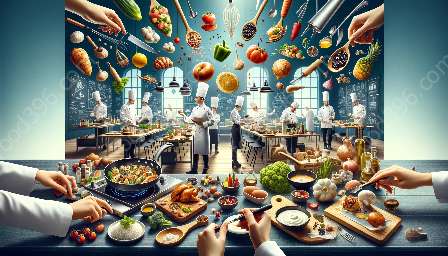Food styling and photography techniques play a crucial role in the culinary world. They go beyond just the taste and quality of the dishes to enhance the visual appeal and presentation of culinary creations. Whether you are a culinary professional, enthusiast, or are undergoing culinary training, mastering food styling and photography can elevate your skills and provide a competitive advantage in the industry.
Understanding Food Styling
Food styling is the art of arranging, preparing, and presenting food for visual appeal. It involves creating aesthetically pleasing compositions and ensuring that the food looks its best in front of the camera or in person. Effective food styling enhances the overall dining experience and stimulates the viewer's appetite through enticing visuals.
Key elements of food styling include:
- Color and Contrast: Utilizing a mix of vibrant and complementary colors to make the dishes visually appealing and appetizing.
- Texture: Incorporating contrasting textures to add depth and visual interest to the dishes.
- Props and Backgrounds: Selecting appropriate props and backgrounds to complement the food and create a cohesive visual story.
- Plate Presentation: Paying attention to the arrangement of elements on the plate to create an appealing and balanced composition.
Essential Food Photography Techniques
Food photography is the art of capturing and showcasing culinary creations in a visually appealing manner. Whether for professional purposes, social media, or personal documentation, mastering food photography techniques can significantly amplify the visual impact of your dishes.
The following are essential food photography techniques:
- Lighting: Understanding and manipulating natural and artificial lighting to highlight the food's features and create a captivating visual impact.
- Composition: Employing compositional techniques such as the rule of thirds, leading lines, and symmetry to create visually engaging food images.
- Depth of Field: Using shallow or deep depth of field to control focus and draw attention to specific elements of the dish.
- Styling for the Camera: Adapting food styling techniques specifically for the camera to capture the best angles and perspectives of the dishes.
Integration with Culinary Techniques
Food styling and photography techniques seamlessly integrate with culinary skills and techniques, resulting in a holistic approach to presenting and documenting culinary creations. Culinary professionals can use their knowledge of flavor profiles, cooking methods, and plating techniques to inform their food styling choices, ensuring that the visual presentation aligns with the intended sensory experience.
Culinary training programs that incorporate food styling and photography provide a well-rounded education, preparing students to not only create delicious dishes but also to visually showcase their creations in a compelling manner. By understanding the principles of food styling and photography, future chefs and culinary professionals can enhance their ability to communicate their culinary vision through visuals.
Benefits of Food Styling and Photography in Culinary Training
For culinary students, integrating food styling and photography into their training offers several benefits:
- Enhanced Presentation Skills: Students learn how to present dishes in an aesthetically pleasing and professional manner, preparing them for the expectations of the industry.
- Portfolio Development: Students can build a portfolio of visually captivating culinary creations, which can be invaluable when seeking employment or establishing their own culinary ventures.
- Marketing and Branding: Understanding food styling and photography equips students with the skills to effectively market and brand themselves as culinary professionals.
- Engagement and Influence: Mastering these techniques enables students to captivate audiences and influence through the visual representation of their culinary expertise.
Practical Application of Food Styling and Photography Techniques
For culinary professionals and enthusiasts, mastering food styling and photography techniques opens up various opportunities for practical application. These include:
- Social Media Marketing: Creating compelling visual content for social media platforms to showcase culinary creations and engage with a broader audience.
- Culinary Publications and Blogs: Contributing visually stunning content to culinary publications and blogs for exposure and recognition within the industry.
- Menu Development: Collaborating with restaurants and hospitality businesses to visually elevate their menus through captivating food photography and styling.
- Culinary Events and Workshops: Conducting demonstrations and workshops to educate others on the art of food styling and photography, sharing expertise and knowledge with aspiring culinary professionals.
Conclusion
Food styling and photography techniques are essential skills that complement culinary expertise and amplify the visual impact of culinary creations. Understanding the principles of food styling and photography not only enhances the overall dining experience but also equips culinary professionals and students with the tools to captivate and engage audiences through compelling visuals. By integrating these techniques with culinary training, individuals can establish themselves as well-rounded culinary experts with the ability to create, present, and document culinary masterpieces in a visually captivating way.

